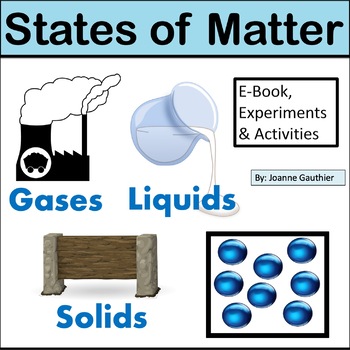States of Matter Unit for Primary Students
Description
This States of Matter primary unit explores the basics of the 3 states of matter through clear visuals, hands-on experiments and critical thinking activities. The zip file contains 9 documents: 7 PDFs, 1 editable PowerPoint and 1 epub file. The entire product includes the following:
An E-book which presents a basic overview of the 3 States of Matter using simple language and clear, realistic visuals.
- The PDF version of the E-book can be printed off as a class book or projected for a whole class presentation. It can also be sent home for distance learning.
- A epub version of the PDF is also included in the zip file. This version includes audio and can be downloaded onto an I-pad into I-books for your emerging and non-readers to access and listen to. It can also be downloaded onto other tablets which have a e-pub reader app.
Note: The E-book is available separately: States of Matter: E-book for Primary Students
Sorting activity (PowerPoint and Worksheet)
- 18 images are presented for the students to sort into the different states of matter.
- There is a PowerPoint for showing color versions of the images and then a worksheet with the same images in black and white. There is also a PDF version should you not have access to PowerPoint.
- The black and white images are to be cut out and pasted onto the worksheet, categorized into Solids, Liquids and Gases.
- The PowerPoint is editable so you could add more images if you wished.
Six Hands-on Experiments (2 on each state of matter).
Each experiment comes with a detailed explanation on how to prepare the experiment, materials needed and questions to ask before, during and after. The questions asked are:
- How do solids melt?
- How long do different liquids take to cool into a solid?
- What will be created if you mix vinegar and baking soda?
- What is the fastest way to melt a cube of ice?
- What happens when you add force to a substance?
- What happens if you drop some raisins in different liquids?
Seven “What if” scenarios
Students are given a visual of an unrealistic situation and are asked to explain what would happen in the presented scenario, given the properties of the different materials. The scenarios presented are:
- If I build a house of wax
- If I build a table of water
- If I fill a swimming pool with jello
- If I make paper out of smoke
- If I fill a balloon with water
- If I make a car of oil
- If I put bricks instead of ice cubes in a drink.
Story starters and 1 graphic organizer for a story on the adventures of water in its different states of matter
Worksheets for writing the characteristics, changes, similarities and differences of the states of matter.
Evaluation rubric and answer key
This resource is also available in French/Aussi disponible en français:
Other science resources you may be interested in:
Animals: Non-Fiction Readers for Beginners and Research Templates
Animal Adaptations: E-Book for Primary Students
Community Workers: Non-Fiction Readers for Beginners
Bodies, Muscles and the Five Sense: Non-Fiction E-book for Primary Students
Healthy Living and the Fight Against Germs: Non-Fiction E-book for Primary Students





